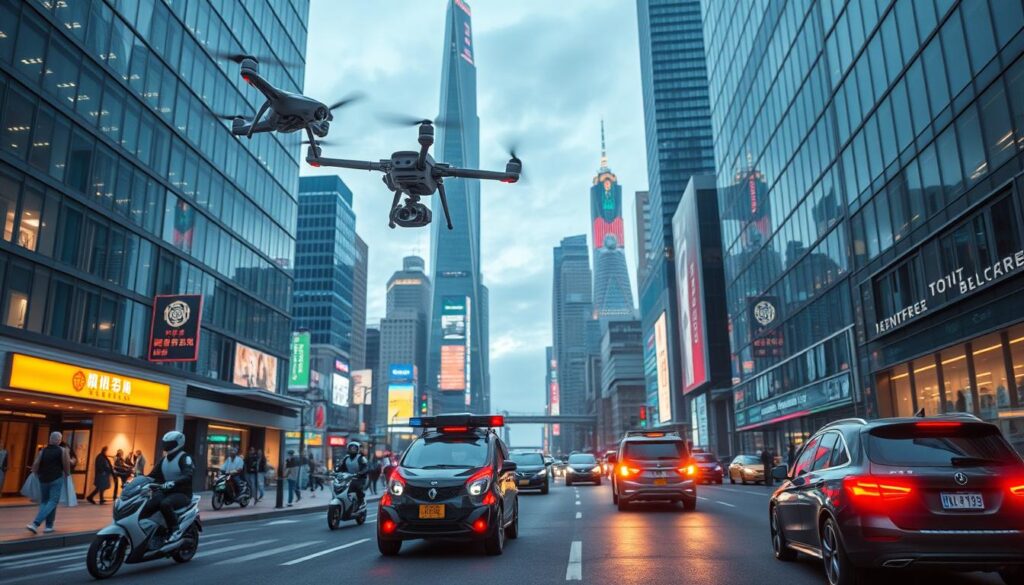Did you know 82% of supply chain groups are focusing on logistics in 2024? This shows a big change in many industries. They’re using automation and new tech to make things better. Robotics is getting more advanced, and it’s key for companies to keep up.
They’re looking at strong process automation (RPA) to make logistics smoother and manage inventory better. This means they want to work smarter, with less human help. It helps them grow and change faster.
This article will look at new trends in robotics for 2024. We’ll see how they affect different areas like manufacturing, healthcare, and logistics. You can also check out this resource for more on RPA in logistics. Get ready to see how robotics is changing the way we work in a fast-changing world.
Key Takeaways
- Automation is changing how industries work, especially in logistics.
- Robotic Process Automation (RPA) is key for making tasks more efficient.
- AI is set to change logistics and inventory management a lot.
- Planning carefully is crucial for making RPA work well.
- 82% of supply chain groups see logistics as a top priority for 2024.
Introduction to Robotics Trends in 2024
The world of robotics is changing fast, and 2024 will bring new robotics trends that will change many industries. More companies are using automation in their daily work. This makes them work better and more efficiently.
Now, 82% of companies are focusing on logistics, especially on managing their stock. This is a great chance for new ideas to come in. It shows we need smart solutions to make things run smoother and solve business problems.
Artificial intelligence (AI) and robotic process automation (RPA) are big news this year. They aim to make many tasks automatic. This change helps companies work better, manage data well, and make smarter choices. Companies like EcoFlow are leading the way with products like the Delta 3 Plus power station. It shows how new tech can meet our energy needs in a changing world.
As we move into 2024, robotics and new tech will change how businesses work in many areas. Keeping up with these changes is key to staying ahead in the market.
Automation and Its Impact on Industries
Automation is changing how modern industries work, making things more efficient and productive. Companies in many fields see the big benefits of automation impact on their work. They use robotics to boost productivity and cut down on mistakes.
When industries use automation, they see big improvements in how well they work. For example, in logistics, companies use robotic process automation (RPA) to manage inventory better. This makes operations smoother and cuts down the time workers spend on repetitive tasks. It’s leading to a big industry transformation.
The following table shows the good and bad sides of RPA in logistics, based on APQC’s Open Standards Benchmarking database:
| Benefits of RPA | Barriers to RPA Adoption |
|---|---|
| Enhanced quality of logistics tasks | High implementation costs |
| Reduced processing time | Technology limitations |
| Minimized human involvement | Resistance to change within organizations |
| Improved data accuracy | Need for employee training |
As companies look for ways to stay ahead in a fast-changing tech world, the value of using data becomes clear. The Open Standards Benchmark repository has the latest info important for making decisions and improving skills. Keep up with these trends as they will guide the future of many industries.
Advancements in Robotic Process Automation (RPA)
The world of robotic process automation is changing fast. More companies, especially in logistics, are using these new technologies to make things run smoother. About 25% of businesses have started using RPA, showing a big move towards automation.
Current Adoption Rates of RPA
Companies are turning to automation to improve their work. In the logistics field, over 42% of companies in certain areas like consumer goods are using RPA. This shows a big push towards using RPA to boost productivity and work performance.
Benefits of RPA in Logistics
RPA brings many benefits to logistics. It helps with things like planning shipments and managing inventory. Companies using RPA often see better work quality, follow rules better, and have fewer risks. About 70% of companies say they have fewer mistakes and less rework, proving RPA’s impact on logistics.
To learn more about RPA and its effects, check out this RPA audit guide. It can help your business make big improvements.
Integration of AI in Robotics
Artificial intelligence is changing how robots work in big automation tasks. It’s key to making things better, faster, and more efficient in many areas.
Transforming High-Volume Processes
AI lets robots do big tasks quickly and accurately. They use smart algorithms to look at lots of data and make quick decisions. This makes making things faster and more precise.
AI’s Role in Enhancing Efficiency
AI makes robots work better by using new tech. They can learn from their surroundings and adjust easily. This means they work better, have less downtime, and do more.

AI does more than just help with work tasks. Companies see that adding smart care solutions can really help patients. By using AI for monitoring and data analysis, they can handle complex supply chains better and work more efficiently.
| Technology | Applications | Benefits |
|---|---|---|
| AI in Robotics | Manufacturing Automation, Logistics | Increased Speed, Real-time Decision Making |
| Machine Learning | Process Optimization | Enhanced Flexibility, Reduced Downtime |
| Data Analytics | Supply Chain Management | Informed Decision-making, Improved Efficiency |
Robotics in Manufacturing: What to Expect
By 2024, robotics in manufacturing will see big changes. These changes will make factories smarter, with robots doing repetitive tasks on their own. This will lead to better precision and less time in production, fitting with today’s automation trends.
More companies will invest in flexible robots as they see the need for change in their production lines. This flexibility helps companies quickly adapt to new market needs, making them more resilient. Robots will work with humans, not just replace them, boosting productivity greatly.
Looking at the manufacturing world, robotics is changing the game. It makes operations more efficient and brings new ways to improve quality. Companies are jumping on this bandwagon to stay ahead in a fast-changing market. For instance, keep an eye on the new Netflix series “Monsters: The Lyle and Erik Menendez.
The future of robotics in manufacturing looks promising. It will change how we think about making things and working together. These technologies will impact productivity, jobs, and the economy in big ways.
Robotic Innovations in Healthcare
Robotic innovations are changing healthcare, especially in patient care automation. AI helps make diagnostics faster and patient monitoring more efficient. This leads to better experiences for patients. Robots help in recovery and support healthcare workers in giving top-notch care.
AI and Automation in Patient Care
Robots make patient care better by automating tasks. This lets doctors focus on important parts of treatment. The main benefits are:
- Quicker response times thanks to real-time data analysis.
- Better accuracy in checking on patients.
- Help with sticking to treatment plans through automated reminders.
As technology gets better, automation meets the need for more personalized care. This shows a move towards advanced healthcare innovations that focus on being efficient and making patients happy.
Future Technologies in Surgery
The future of surgery is bright, thanks to surgical robotics that make procedures more precise. These healthcare tech advancements include:
- Less invasive surgery, which cuts down recovery time.
- Advanced robots that give surgeons better views and control.
- Tele-surgery options, making expert care available worldwide.
As robots get better, the healthcare field expects big steps forward in surgery. This will lead to better results for patients.
| Technology | Description | Benefits |
|---|---|---|
| Patient Monitoring Systems | Automated systems for tracking health metrics. | Real-time updates and alerts for healthcare staff. |
| Surgical Robots | Robotic assistance during surgical procedures. | Increased precision and reduced surgery time. |
| Rehabilitation Robots | Devices supporting physical therapy and patient mobility. | Enhanced recovery speed and efficacy. |
The Role of Robotics in the Supply Chain
In 2024, using robotics in supply chain processes is key for companies wanting to improve. They focus on logistics technology to manage inventory better and work more efficiently. By adding automation, companies see better operations and stronger logistical skills.
Statistics show that 82% of supply chain groups plan to invest in logistics this year. About 25% of companies use Robotic Process Automation (RPA) in their logistics. This shows that advanced technology is the future of managing supply chains. RPA helps save time and lowers risks.
Using RPA well is important for companies to get the most out of it. The APQC says that improving processes and tech issues are big hurdles. But, having a strong data strategy helps in using RPA well, especially during global challenges.
Today, being quick in supply networks means focusing on automation in supply chain logistics. This includes tracking shipments, filling orders, and keeping an eye on inventory. For more on RPA’s benefits and challenges in logistics, check out the link provided.
Challenges Facing the Robotics Industry in 2024
The world of robotics is full of both big chances and big challenges. Companies want to automate more, but they face hurdles. Two big ones are the costs and the limits of technology. These are key to making robots work well.
Implementation Costs
Robotics can make things more efficient and productive, but it’s not cheap. Companies must think about the costs versus the benefits. Over half of those surveyed say costs are the main issue with using Robotic Process Automation (RPA).
This means planning and budgeting carefully is key. It helps make sure the investment pays off.
Technology Limitations and Process Streamlining
When thinking about using robots, you must look at the tech limits. Many companies need to make their processes better first. Finding and fixing bottlenecks helps make automation work better.
Ignoring these tech limits can lead to trouble. Companies might not get the most out of robots, causing frustration and less productivity.
| Category | Percentage of Organizations Reporting |
|---|---|
| Implementation Costs as a Barrier | 50% |
| Automation Improved Quality | 70% |
| Time Savings from RPA | 50% |
| RPA Adoption in Consumer Goods | 42% |
| RPA Adoption in Petroleum | 7% |
| Organizations Likely to Adopt RPA | 66% |
Conclusion
This article has shown us the bright future of robotics, with many trends shaping the industry in 2024. Sectors like healthcare and supply chain are turning to automation. They’re using advanced tech like artificial intelligence and generative AI more and more.
Almost all supply chains are looking into generative AI. This shows how these new technologies will change how things work.
But, we must also look at the challenges these new tech bring. Things like high costs and the need for special AI skills are important to consider. Companies are spending a lot on these technologies, seeing big growth in the AI Project Management market.
This shows they understand the big benefits of saving money and working more efficiently.
To make the most of robotics and automation, it’s key to use these technologies wisely. As we move forward in 2024, keeping up with new trends and challenges will help your business succeed and change for the better.
FAQ
What are the main robotics trends expected in 2024?
In 2024, we’ll see more automation in many industries. Robotic process automation (RPA) will grow, and AI will blend into robotic systems. This will make things more efficient and productive.
How is automation impacting various industries?
Automation is making things run smoother in fields like manufacturing, healthcare, and logistics. It’s boosting quality, making things more efficient, and speeding up responses.
What is the current state of RPA adoption?
About 25% of companies in logistics have started using RPA. In consumer goods, that number jumps to 42%. This shows a big push towards automation.
What benefits does RPA provide in the logistics industry?
RPA helps logistics by making tasks like scheduling and managing inventory better. This leads to better work quality, more compliance, and fewer mistakes.
How does AI integration transform robotics?
Adding AI to robotics lets robots make quick decisions and handle big data. This makes operations smoother and lets robots adjust to different settings.
What impact will robotics have on manufacturing in 2024?
In 2024, manufacturing will see more smart factories. Robots will do repetitive tasks on their own. This means more precision and shorter production times.
How are robotic innovations transforming patient care?
Robots with AI are helping with diagnostics and watching over patients in healthcare. They’re making things faster and helping patients recover quicker.
What challenges are organizations facing when implementing robotics?
Companies face big costs when adding robotic tech. They also need to make sure their processes are ready for automation to work best.
How does robotics optimize supply chain processes?
Robotics makes supply chains better by automating tasks, managing inventory well, and creating a more connected and quick system.
Source Links
- https://www.scmr.com/article/rpa-benefits-and-barriers
- https://www.scmr.com/article/the-benefits-and-challenges-of-rpa-in-logistics
- https://www.scmr.com/article/learning-from-the-past-to-invent-the-future-of-last-mile-logistics
- https://www.zdnet.com/home-and-office/ecoflows-new-delta-3-plus-can-power-a-refrigerator-for-5-hours-after-a-30-minute-charge/
- https://www.prnewswire.com/news-releases/bd-completes-acquisition-of-critical-care-from-edwards-lifesciences-302237204.html
- https://www.engineering.com/goengineer-acquires-inceptra/
- https://www.roboticstomorrow.com/article/2024/08/what-is-an-rpa-audit-and-how-do-you-know-if-you-need-one/23000
- https://hackernoon.com/advanced-llm-development-101-strategies-and-insights-from-igor-tkach-ceo-of-mindy-support
- https://www.scmr.com/article/synchronizing-supply-chain-planning-execution-analytics/procurement
- https://www.therobotreport.com/luxolis-provides-3d-vision-data-tools-for-robot-precision-in-electronics-manufacturing/
- https://edtechmagazine.com/k12/article/2024/09/how-can-k-12-educators-teach-blind-students-code
- https://www.sanjoseinside.com/news/silicon-valley-puts-its-tech-expertise-to-work-fighting-fires-with-fire/
- https://news.bd.com/2024-09-03-BD-Completes-Acquisition-of-Critical-Care-from-Edwards-Lifesciences
- https://www.openpr.com/news/3644293/ai-enhances-rehabilitation-and-assistive-technologies-market
- https://usccg.com/?post_type=post&p=8984
- https://medium.com/majordigest/defense-intel-teams-monitor-earth-and-space-with-broad-area-management-a519a4c291e0
- https://solutionsreview.com/business-process-management/generative-ai-optimizes-costs-with-smarter-resource-allocation/
- My Guide to Understanding Data Centre Architecture: Core Components Every IT Pro Should Know
- Wazuh Home Network Setup: A Step-by-Step Guide
- Quantum Computers Decrypting Blockchain: The Risks and Implications
- Wazuh: Enterprise-Grade Security for Your Business
- Wazuh for Beginners: A Comprehensive Guide




